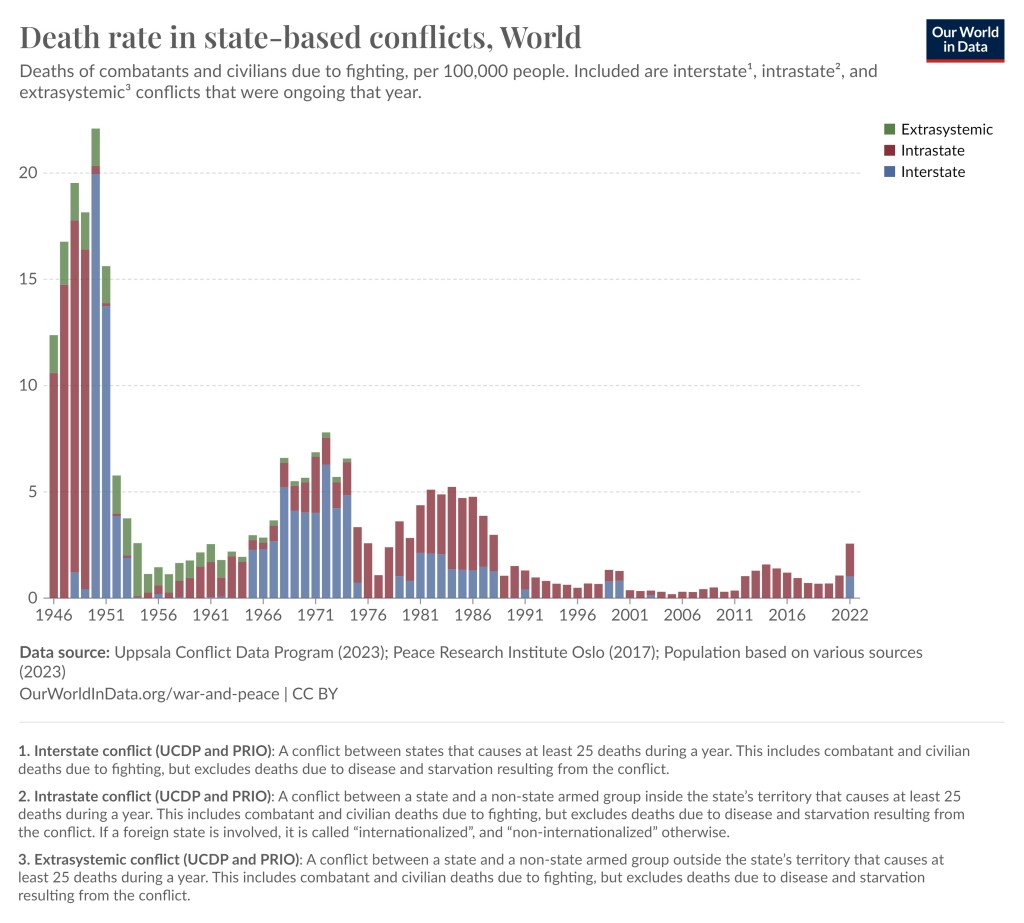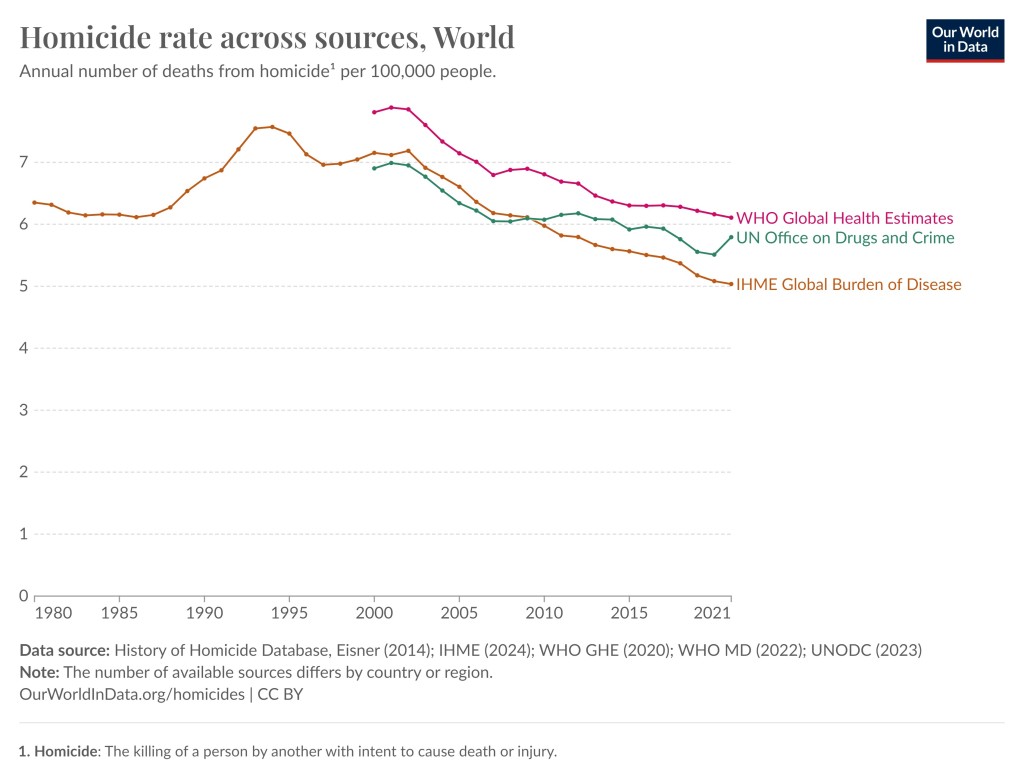Superfact 9 : We are living in relatively peaceful times
Despite all the wars going on, the world was filled with a lot more war and violence in the past. Despite the grim news reports we are living in relatively peaceful times.
If I asked you, what are the two biggest wars going on the world today (as of September 2024), you would probably say that it is the Russia / Ukraine war and the Israel / Gaza war. Well, unless you are really well informed, it would come as a surprise that there are more devastating wars going on in the world. For example, there is currently a big civil war going on in Sudan that began in April 2023.
According to the latest issue of the Economist perhaps 150,000 people have been slaughtered in this civil war, and 10 million people have fled their homes, and a famine is emerging that could kill 2.5 million people by the end of the year. This war is likely to destabilize neighboring countries and is sponsored by Russia and Middle Eastern states. It’s likely the biggest crisis in the world but most likely you’ve never heard of it.

In the recent Tigray war in Ethiopia between 162,000 and 600,000 people were killed according to Wikipedia. The Tigray war is mostly over, but the point I am trying to make is that you probably have never heard of it. You cannot use the impressions given by the amount of media attention a conflict gets to decide on how severe it is. You’ve got to check the statistics and compare, and the statistics might be quite unintuitive if you have relied on media attention as a metric.
What was the most devastating war in the 19th century?
So, to the next question. What was the most devastating war in the 19th century? If you say the American civil war, you are not correct (estimated 650,000+ deaths). A somewhat better answer is the Napoleonic wars (and estimated 4 million deaths). But none of the answers are correct. The Taiping rebellion in China was the worst. Estimates of the conflict’s death toll range between 20 and 30 million people. Some estimates say 100 million, which would make it the most devastating war in human history.
But did you hear about it? Again, you’ve got to check the statistics, and not rely on your impressions. I am saying this because the claim that deaths from wars and violence have declined over the last few decades is a quite unintuitive claim and yet it is true. That’s why it is a super fact.

As this article in the Our World In Data states “While every war is a tragedy, the data suggests that fewer people died in conflicts in recent decades than in most of the 20th century. Countries have also built more peaceful relations between and within them.”. It should be noted that even though killing has never been as efficient as it is in the present, in the past a lot of civilians died from famine and disease resulting from the wars.
For example, the Spanish flu following World War I killed between 25 to 50 million people. I should say those numbers are typically not included in the deaths from World War I. The number of deaths from World War I are estimated at 20 million. 10 million combatants and 10 million civilians.

One problem with this kind of statistics is that the estimates vary, especially with respect to civilian causalities. In addition, very big wars lasting a few years create very bumpy graphs with large spikes making it harder to identify trends.
However, by listing estimated war deaths of the biggest wars, genocides and democides since the 1800’s you can see that deaths from this type of violence have overall been reduced over the last few decades. A note, democides are mass killings of civilians but are not necessarily directed at an ethnic group (democide include genocide).
The links below are mostly from Encyclopedia Britannica, but also from Wikipedia, the Census bureau, and a couple of other sources.
- Napoleonic wars – estimated 4 million deaths (or 3,250,000 to 6,500,000)
- Taiping rebellion, China, 1850 to 1864 – estimated deaths 20 to 30 million people.
- Congo free state genocide 1885 to 1908 – estimated 1.5 million to 13 million (median 5 million)
- First World War 1914 to 1918 – estimated deaths 15 to 22 million deaths.
- Armenian genocide 1915 to 1917 – estimated deaths 600,000–1.2 million.
- Russian civil war 1917 to 1922 – estimated 10 million deaths.
- The Chinese Civil War (1927-1950) – estimated deaths 7 million.
- Second World War 1939 to 1945 – estimated deaths 70 to 85 million deaths.
- Holocaust 1941 to 1945 – estimated 6 million Jews plus 5 million others.
- Soviet killing of citizens 1920 to 1960s (democide) – estimated 20 million deaths, maybe more.
- Korean War 1950 to 1953 – at least 2.5 million deaths.
- Algerian war of independence 1954 to 1962 – an estimated 500,000 to 1,500,000 deaths.
- Vietnam War 1954 to 1974 – an estimated 3.4 million deaths.
- Khmer Rouge in Cambodia – an estimated 1.6 to 3 million deaths.
- First Sudanese civil war 1955 to 1972 – an estimated 500,000 to one million deaths.
- Biafra war 1967 to 1970 – an estimated 500,000 to 3 million deaths.
- Second Sudanese civil war 1983 to 2005 – an estimated -1 million to 2 million deaths.
- Somalia civil war 1988-1990 – an estimated 350,000–1,000,000.
- Yugoslav civil war 1992 to 1995 – an estimated 130,000-140,000 deaths.
- Rwandan genocide 1994 – an estimated 800,000 deaths.
- The Second/Third Congo War 1996 to 2007 – an estimated 5.4 million deaths.
- Syrian civil war 2011 to now – an estimated 600,000 deaths.
- Ethiopian Tigray war 2022 – an estimated 162,000–600,000 deaths.
- Ukraine – Russia war 2022 to now – some estimates say 200,000 deaths.
- Sudanese civil war 2023 to 2024 – an estimated 150,000 deaths.
As I said, the numbers are estimates and not hard data, especially with respect to civilian casualties. However, you can see a trend going from several conflicts with numbers in the tens of millions before 1950, then numbers in millions until 2000/2007 and then during the last couple of decades the numbers have been less than a million. This does not cover homicide rates but even in that case we can see a reduction even though it is less distinct.

Finally, you can also take a look at this post “US Violent Crime Nearly Cut in Half Since 1990” and this article from pew research that includes a graph showing that the US violent crime rate has nearly halved since the 1990’s.
Also remember that in the past there were a lot less people on earth, so relatively speaking a million deaths was a lot bigger number back then. In summary, despite all the wars going on, our world is less violent than it used to be.

